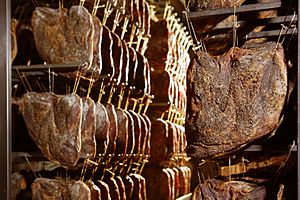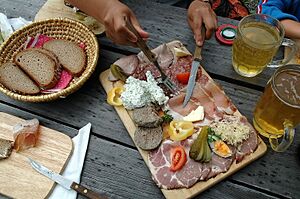Speck Alto Adige PGI facts for kids

Speck Alto Adige PGI
|
|
| Alternative names | Cioce |
|---|---|
| Place of origin | Italy |
| Region or state | South Tyrol |
| 300 kcal/1.254 KJ kcal | |
Speck Alto Adige PGI is a special kind of ham made in South Tyrol, a region in northern Italy. It is called Cioce or Ciociul in the Ladin language and Südtiroler Speck g.g.A. in German. This ham is dry-cured and lightly smoked.
The way Speck Alto Adige PGI is made is protected by the European Union. It has a special status called protected geographical indication (PGI). This means it must be made in a certain place and in a traditional way. Unlike other hams like prosciutto, Speck Alto Adige is smoked.
Contents
The Story of Speck
Speck has a very long history! People first wrote about "speck" in the 1700s. But even way back in the 1200s, people in Tyrol were making similar meats.
People first made speck to keep meat fresh for a long time. This helped families have meat all year, especially from pigs prepared around Christmas time. For many poorer people, speck was an important way to get meat and fats. Over time, it became a popular food for big parties and celebrations. Even today, it is a main part of the traditional South Tyrolean "snack" served with bread and wine.
Speck is a very special food from South Tyrol. It combines two different ways of keeping meat fresh. One way is curing, which comes from the Mediterranean area. The other way is smoking, which is common in Northern Europe. South Tyrol is located between these two areas. Its unique climate helped people combine these methods. They created speck using the rule: "a little salt, a little smoke, and a lot of fresh air." This means it is lightly cured and gets both smoke and fresh air.
At first, only farming families made speck. Later, local butchers started making it in their shops. By the 1960s, it became a product made by larger companies.
How Speck is Made
Making Speck Alto Adige involves light smoking and a long curing time. The process takes about 22 weeks. A special salt crust is used, but it must be less than 5% of the final product.
All speck makers, big or small, follow the rule: "a little salt, a little smoke, and a lot of fresh air." The production has five main steps:
- Choosing the right meat
- Salting the meat
- Smoking the meat
- Curing the meat
- Checking the quality
Choosing the Meat
To make Speck Alto Adige PGI, only lean and firm pork thighs are used. The meat is carefully chosen and trimmed in a traditional way. Each piece is marked with the date it started production. This helps with later quality checks.
Salting and Flavoring
The pork hams are salted and flavored with a mix of spices. These spices include salt, pepper, juniper, rosemary, and bay leaves. The hams are then dry-cured for three weeks. This happens in special rooms with controlled temperatures. The hams are turned often so the salt and flavors spread evenly.
Smoking and Drying
After salting, the hams are smoked and dried in turns. The smoking is light and uses wood that doesn't have much resin. This keeps the speck from having too strong a smoky taste. The smoke temperature must always be below 20 °C (68 °F).
Curing and Aging
In the last step, the hams are cured. They are hung to dry in rooms with lots of fresh air. The aging time depends on the ham's final weight. It usually lasts about 22 weeks. During this time, a natural layer of mold grows on the hams. This mold is removed at the end of the process. This mold layer helps give speck its special taste. It also stops the ham from getting too dry.
Final Checks
Speck that meets all the production rules is marked with a special seal. This seal is fire-branded in four different spots on the rind.
Quality Checks and Special Mark
Speck Alto Adige PGI is protected by the European Union. This means it has a Protected Geographical Indication (PGI) status. This special mark is only given to products made in traditional ways and in specific areas.
To make sure Speck Alto Adige PGI is always high quality and real, there's a special group called the Südtiroler Speck Consortium. They work with an independent group called INEQ. Together, they check every step of the production. They check from when the meat is chosen all the way to the finished product.
Nutrition Facts
Speck Alto Adige PGI has a lot of protein. Here are the nutrition facts for 100 grams (about 3.5 ounces):
| Energy | 1.254 kJ (300 kcal) |
| Protein | 30.70 g |
| Fat | 19.10 g |
| Carbohydrates | < 0.50 g |
Speck in the South Tyrolean Snack
In South Tyrol, speck was traditionally a farmer's meal. It gave them energy for their hard work in the fields. Over time, it became a main dish for celebrations and welcoming guests. This tradition continues today. Speck, along with bread and wine, is served as the typical South Tyrolean "snack." It is a sign of being friendly and welcoming.
The local name for this snack is "Marende" (or "Brettljause" in German). The snack is served on a wooden cutting board. It has speck, sausages, local cheeses, and pickled cucumbers. It comes with farmer's bread and wine. For the "Marende," the speck is usually served in a single piece about 3 cm (1.2 inches) wide. Then, people cut it into smaller pieces to eat.
Events About Speck Alto Adige PGI
The most famous event for Speck Alto Adige PGI is the Südtiroler Speckfest. This is a traditional speck festival held every fall. It takes place in St. Magdalena, a town in Villnöß/Funes, at the foot of the Dolomites mountains. The Südtiroler Speckfest is organized by the Villnöß tourism group, the Südtiroler Speck Consortium, and the EOS – South Tyrol Export Organization.
Each year at the festival, a master speck slicer named Hans Mantinger, also known as "Gletscherhons," creates amazing speck dishes.




